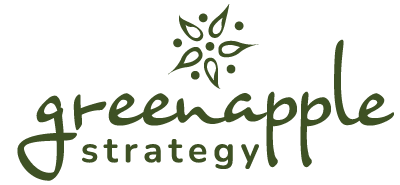From Strategy to Execution (Part Two of Two-Part Series)
After you set your strategy, the reality of marketing life sets in. That clear roadmap you created starts competing with daily fires. The CEO has a “quick question.” Sales needs an emergency brochure. There’s a complicated product launch or a last-minute industry event next month that needs support. Suddenly, everything feels urgent, and your meticulously crafted long-term strategy starts to slip. How do you know when something is a timely opportunity or a threat to sustained success?
For small to mid-size businesses, it’s easy to lose focus when everything feels like a priority. You’ve invested time and money into a great plan. Now you need systems to protect it from being overcome by the daily chaos.
At Green Apple Strategy, we know this feeling well. We work with lean teams every day, and we’ve learned that keeping a strategy on track requires simple, practical discipline, not endless hours.
In part two of our From Strategy to Execution series, we’ll share practical ways to prioritize, delegate, and pace your marketing efforts when the urgency dial is turned all the way up.
Didn’t Catch Part One?
Before you manage the requests, make sure you nailed the launch! If you’re still in the process of putting your strategy into motion, be sure to grab our guide: How to Activate Your Marketing Strategy: A Checklist for the First 90 Days. It’s the essential roadmap for building momentum from the very beginning.
Tactics for Taming the Chaos
1. Revisit Your Strategy Before Reacting
When things get chaotic, your strategy is your anchor. Before you add another task to your list, take a breath and ask:
-
Does this align with our business goals?
-
Is it helping us move closer to the metrics that matter?
-
If we say “yes” to this, what are we saying “no” to?
This quick gut check will keep you from getting pulled into short-term distractions that don’t serve your long-term goals.
Pro tip: Keep your marketing strategy visible—literally. Print it, pin it near your desk, or set a recurring calendar reminder to revisit it weekly. When you can see it, it’s easier to stay grounded.
2. Rank Tasks by Impact, Not Noise
When every request feels urgent, it helps to sort your priorities based on impact. The Eisenhower Matrix is a simple system we often use for prioritizing work. You separate tasks into four quadrants based on two factors: urgency and importance.
-
Urgent and Important (Do it now): True crises, mission-critical deadlines.
-
Not Urgent and Important (Schedule it): Strategic planning, content creation, relationship building. This is where your marketing strategy lives.
-
Urgent and Not Important (Delegate it): Meeting requests, simple scheduling, minor production tasks.
-
Not Urgent and Not Important (Delete it): Unnecessary meetings, low-impact ideas, time sinks.
By using this framework, you force yourself to schedule time for the important work that drives long-term success.
3. Protect Strategic Time
Because strategic thinking time often gets put on the back burner when other fires pop up, it can be helpful to block off one or two hours every single week on your calendar. Label this time “Strategic Planning” or “Goal Review.” Treat it as an immovable client meeting.
Use this time exclusively for working on the plan, not in the plan. Review your quarterly milestones. Check key metrics that matter to your leadership team. This simple act keeps the big picture alive.
4. Set Clear Boundaries for Requests
One of the biggest strategy killers is the unscheduled request. It’s incredibly useful to create a simple system for managing internal needs. Here’s just one example:
-
Create a system for taking in ideas and requests: Have all requests (from sales, leadership, etc.) submitted through a single form in your project management tool (like Airtable or Asana).
-
Set a realistic expectation: Communicate that all new requests will be reviewed and prioritized every Monday morning.
-
Triage against the goals: When a request comes in, ask: “Does this move us closer to our Q3 business goal?” If the answer is no, it waits or gets pushed to the “Delete” quadrant.
5. Learn to Say “Not Right Now”
For small teams, this might be the hardest part of staying on track. When leadership or sales comes to you with a new idea, it’s tempting to say yes. But spreading yourself too thin can dilute your results and undermine your strategy.
Instead, try: “That’s a great idea. Let’s add it to our next strategy review and evaluate how it fits with our current goals.”
This response acknowledges the idea while giving you space to decide if (and when) it deserves your attention.
6. Delegate (and Automate) Whenever You Can
You can’t do everything, and you shouldn’t try. Here are some of our most helpful suggestions for bringing project management to your marketing efforts.
-
Leverage your partners. If you work with an agency, let them handle execution-heavy tasks like campaign management, content creation, or reporting. This is one of the biggest benefits of The Green Apple Orchard.
-
Automate Routine Tasks with AI. There are a variety of ways AI can help you improve marketing outcomes, especially when it comes to freeing up time for creativity. Platforms like Claude, AirTable, or Zapier can take repetitive tasks off your plate.
-
Empower your team. If you’re a one-person department, bring other departments in. Sales can help generate content ideas. Customer support can help you reach out for client testimonials or case studies.
Delegation isn’t a sign of weakness. It’s how you make room for the high-value work only you can do.
7. Refocus on Metrics That Matter
When you feel overwhelmed, go back to the numbers that matter most to your business: revenue, retention, reputation.
Ask yourself:
-
Is this activity moving us closer to those metrics?
-
Can we measure its impact clearly?
If not, it might not be worth prioritizing right now.
Pro tip: Keep a simple dashboard (even if it’s a spreadsheet) with three to five core KPIs. Review them monthly to stay centered on what’s actually driving growth.
8. Don’t Let Pivots Kill Momentum
Your original strategy is your compass, but it’s okay if the market forces you to adjust the route. Use your planned check-in meetings to evaluate new opportunities. If a shiny new object aligns perfectly with your goals and has high impact, it may be worth a marketing pivot. But remember, when you pivot, you must also eliminate an equivalent amount of low-impact work from your original plan.
Need Help Staying the Course?
Creating a strong marketing strategy is the hard part. Keeping it on track is the disciplined part. It requires simple boundaries and systems that protect your time from the daily firestorm of urgency. By ruthlessly prioritizing and strategically delegating, you make sure your well-designed marketing plan doesn’t just sit on the shelf. You keep it in motion, driving real, measurable results for your business all year long.
Ready to move beyond the daily chaos and gain momentum with your marketing? Green Apple Strategy can help you build the systems and provide the specialized execution needed to keep your marketing strategy on track. Contact us today to learn more about our strategic planning services.











